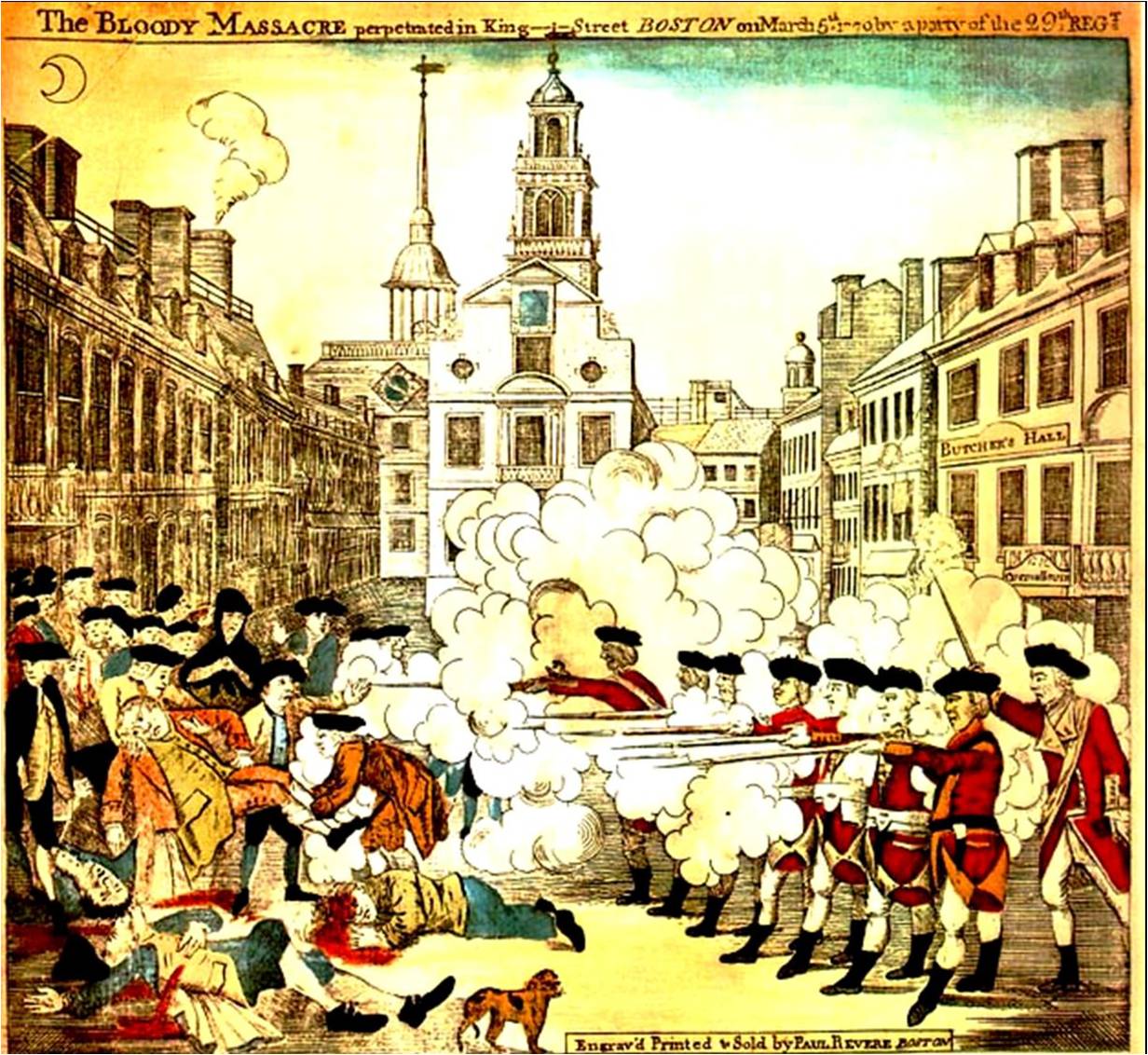The Boston Massacre
The Boston Massacre is a name given later to a deadly confrontation between British soldiers and American colonists in Boston on March 5, 1770. A disagreement escalated to a shouting match, a crowd gathered, more soldiers arrived, and the soldiers fired their guns into the crowd, killing three people right away and injuring several more, some of whom died later. As a result, the focus of American resistance to the British presence in Boston was heightened. Many in Boston and elsewhere were already in edge. Successful agitation had resulted in the repeal of the Stamp Act, but the Townshend Acts were altogether different. Approved in 1768, the Townshend Acts placed tariffs on some of the American colonists' most imported items, including lead, paint, paper, and tea. (A tax on tea would be the focus a few years later of the acts that came to be known as the Boston Tea Party.) As a result, many Americans called for a boycott of the Townshend Acts-taxed items and the Massachusetts colonial government advocated a repeal of the Acts themselves. An escalation of the British practice of impressing Americans into the British Navy, coupled with the seizure of a large ship owned by John Hancock, resulted in many more protests on the streets, especially in Boston. In response, Britain sent more soldiers to Boston. The events that took place on March 5, 1770 vary, according to whom is telling the story. Some accounts say that it all began with an argument over whether a bill had been paid. Some accounts say that a crowd that gathered outside the Custom House, on State Street, turned violent and threw snowballs, bottles, and other projectiles against the British soldiers on duty. At one point, someone in the crowd hurled a wooden club, which knocked Private Hugh Montgomery to the ground. Captain Thomas Preston was the British officer in charge on the day. He insisted that he never gave the order for his troops to fire their guns. Yet at some point, fire their guns they did, and the deaths and injuries mounted. Preston it was who ended the shooting. Among those dead of gunshot wounds was Crispus Attucks, a runaway slave. He thus became the first African-American killed in the Revolution. Also dead right away were James Caldwell, a mariner, and Samuel Gray, a ropemaker. Gravely injured was 17-year-old Samuel Maverick, who died the next day. Irish immigrant Patrick Carr died of his wounds two weeks later. Apprentice Christopher Monk was crippled in the attack and lingered for a decade. Thus, the commonly cited death toll from the attacks is 5. Several other people were injured.
The following day, as part of that inquiry ordered by Hutchinson, 13 people were arrested: Preston, eight soldiers, and four civilians. They eventually stood trial and were defended by none other than John Adams, then a lawyer but soon to be the second President of the United States. In the next few days, Sons of Liberty ringleader Samuel Adams and others identified the shootings as an opportunity to further turn public opinion against the British. One of the main weapons in this drive was an engraving done by Paul Revere. Actually a copy of two other engravings done by other artists, Revere's version was the one most seen because he quickly made copies of it and dispatched them round the countryside. Revere's engraving was a propaganda piece that distorted the facts a bit to fit the narrative. Its title was "The Bloody Massacre in King Street." Revere's engraving shows the British soldiers standing in a straight line and firing in a regular manner. In all likelihood, neither of those things happened, especially because the crowd would have been all around them (and not as docile as the engraving would have them to have been). The engraving also shows a daytime scene devoid of snow and ice; the shots were fired at nighttime, on a cold wintery night. By the time the trial began, however, in late November, the case against the soldiers had become less clear-cut. Despite the "evidence" in Revere's engraving, the case against the soldiers was not altogether strong. The jury, guided by intense arguments from Adams, found the soldiers not guilty of murder but found two of the soldiers guilty of manslaughter, a lesser charge. The sentence was a branding on a hand. Preston had been tried separately, earlier, and had been found not guilty as well. The civilians, tried later, were also found not guilty. (In fact, the main witness against the civilians was later convicted of perjury and was subsequently punished and banished.) It was the first use in American legal history of the phrase "reasonable doubt." The soldiers were declared not guilty of, in the case of two, guilty of manslaughter and punished. But the propaganda efforts of Revere and Samuel Adams were having their effect, most notably in a particularly cargo-damaging set of events in Boston in 1773, involving a shipload of tea. |
|
Social Studies for Kids
copyright 2002–2025
David White



 The crowd by the time that the soldiers fired numbered in the hundreds. Once the shots were fired, the crowd dispersed from the immediate area but then regathered near the state house. Preston called in the rest of his regiment, and only the promise of a full inquiry by Acting Governor Thomas Hutchinson, who had hurried to the scene, achieved the end of the violence.
The crowd by the time that the soldiers fired numbered in the hundreds. Once the shots were fired, the crowd dispersed from the immediate area but then regathered near the state house. Preston called in the rest of his regiment, and only the promise of a full inquiry by Acting Governor Thomas Hutchinson, who had hurried to the scene, achieved the end of the violence.
